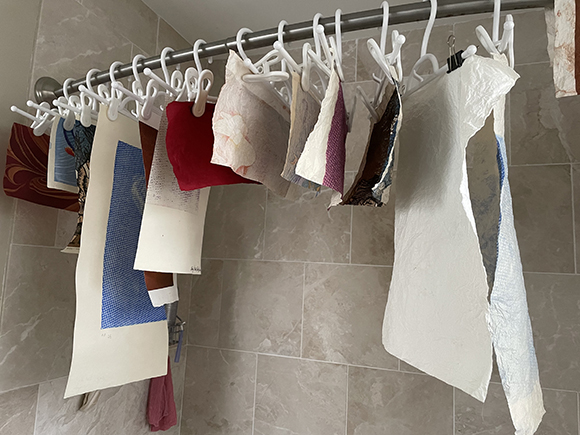Studio blog of Annie Bissett, an artist working with traditional Japanese woodblock printing (moku hanga)
08 February 2022
All About Konnyaku
Many many thanks to "Carpet Bomberz Inc." who left a comment on my last post with a link to an incredible video about konnyaku from NHK World. Check it (available until Jan 2, 2023).
02 February 2022
Momigami Tests
 |
| Unprinted washi after treatment |
 |
| Printed washi after treatment |
Momigami (揉紙) literally means "rubbed paper" and is a process by which a thick high-quality kozo paper is repeatedly crumpled until it softens and takes on a textile-like quality. Often the paper is treated with some kind of additive, usually konnyaku starch. Paper treated this way was historically used in Japan to make clothing, called kamiko. The konnyaku adds strength to the paper, especially wet strength.
I'm entertaining an idea for using self-printed momigami, so I've been researching it a bit. I seem to have exhausted most of my research resources, so yesterday I decided that the best way for me to figure out how to do it was to take the small amount of info I dug up and just do it. So I just did it. I tried to do it in a quasi-scientific way in order to "measure" my results.
I got some konnyaku powder and tried one of the several recipes I found online. I chose the recipe that called for 1 teaspoon of powder in 1 cup of water, and I'm here to tell you it was too thick. I'll use half that amount of powder next time. I used a 2-inch wide brush to apply the starch to both sides of the paper.
In my research I found two different ways of doing the konnyaku and crumpling: one was to apply the konnyaku, crush the paper into a loose ball and then crumple it more before letting it dry. The other method was to coat the paper with the konnyaku, let it dry, and then crumple it. I tried both methods to see if there would be a difference.
 |
| Treated paper hung to dry. In the shower, of course. |
The other thing I was anxious to see was whether the watercolor of mokuhanga-style printing would bleed when soaked with konnyaku and crumpled. I did one sheet of unprinted paper but the rest were rejected mokuhanga prints on several different types of washi.
Here's a report on my results.
• Western cotton rag paper comes out incredibly soft, but it tears easily.
• The thinner the paper the less starch it needs
• Some pigments bleed and offset when wet, especially if crumpled while wet. It seems to be the mineral pigments that bleed. The problem is lessened by doing the crumpling after the konnyaku has dried
• I was surprised to discover that the papers I dried and then crumpled came out softer than the identical papers that I crumpled while wet. My guess is that crumpling while wet drives the starch deeper into the fibers, making them stronger but also "crisper." It turns out that I like my momigami soft.
I still need to do further tests before I settle on what type of paper I'll use for my project.
 |
| Yukimi. Top was crumpled while wet and you can see that some pigment bled into the white border. I think it was burnt sienna. The red/yellow interface stayed surprisingly crisp, though. |
 |
| Shioji. Again, the top was crumpled while wet and the ultramarine blue bled. |
 |
| Echizen Kozo. The red bled when I did the wet crumpling but held up under dry crumpling. This paper, soft by nature, makes a very soft momigami. |
